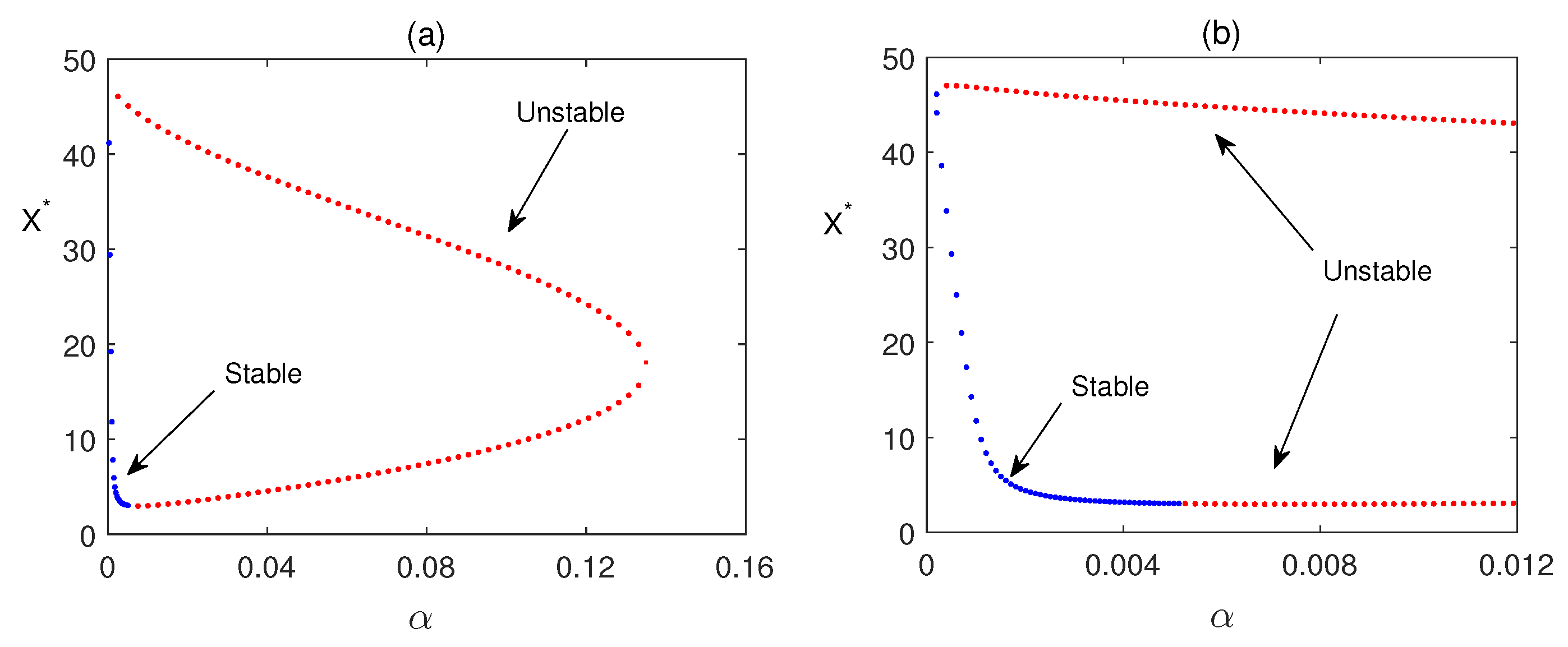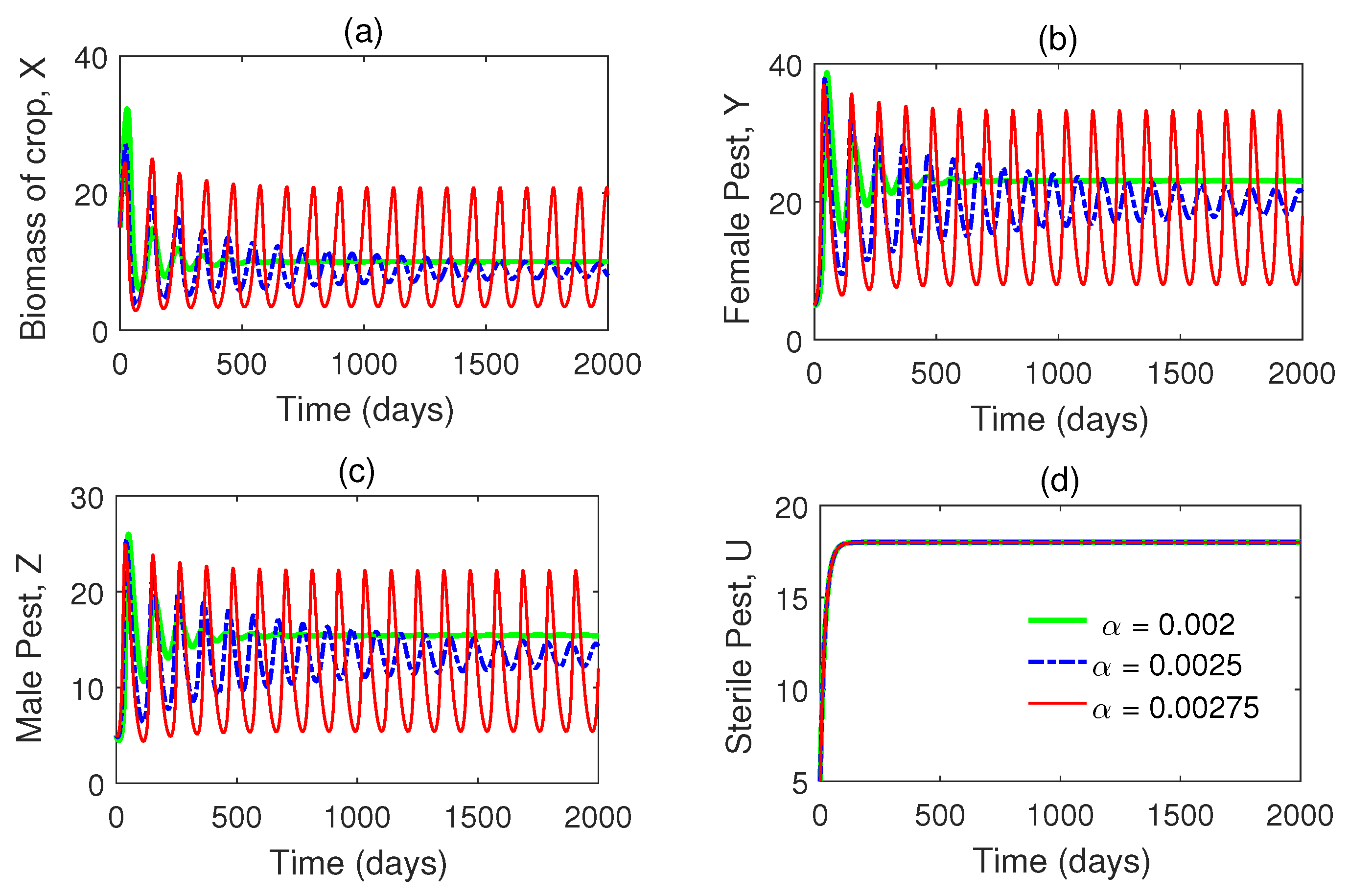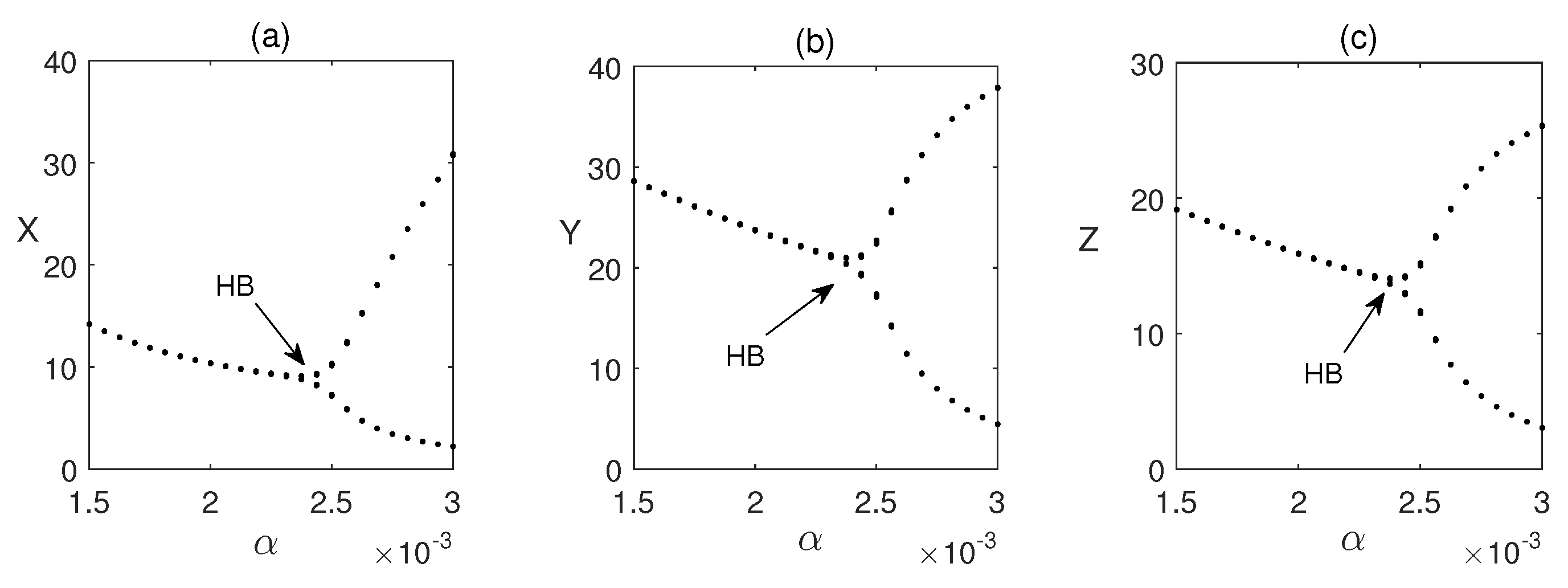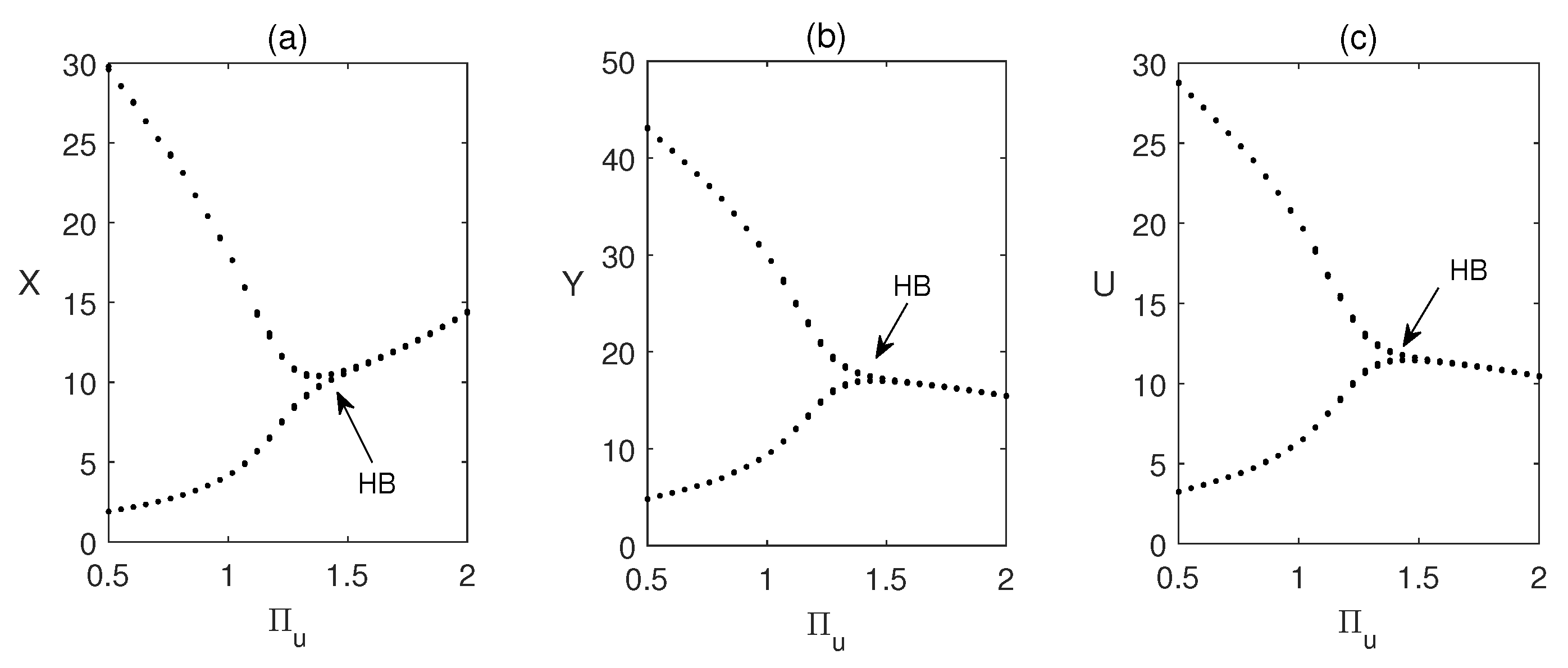1. Introduction
The sterile insect technique (SIT) is a powerful and eco-friendly method of pest control that involves the release of sterilized insects into the environment [
1,
2]. These sterile males, developed via radiation or genetic techniques, interfere with wild males during mating, reducing the number of fertile matings. Since they cannot produce viable offspring, the pest population gradually declines over successive generations [
3]. SIT has been effectively adopted in numerous agricultural environments to manage pests such as fruit flies, mosquitoes, and moths [
4]. By reducing reliance on chemical pesticides, SIT helps maintain ecological balance and prevents resistance development in pest populations. Mathematical models play a crucial role in optimizing SIT strategies by analyzing pest dynamics, determining the ideal release rates of sterile insects, and evaluating long-term population suppression [
5,
6,
7].
The female pest population plays a vital role in the reproductive cycle. New pests are generated through mating between female and fertile male pests, with a fixed proportion of the offspring being female [
8]. However, when sterile male pests are introduced into the environment, they compete with fertile males for mating but do not produce viable offspring. This reduces the overall reproductive success of the pest population. The growth of the female population is thus modeled as a function of mating success, which is disrupted by the presence of sterile males. Furthermore, female pests experience natural mortality and additional losses due to sterile mating interference [
9,
10,
11]. Likewise, the male pest population arises from the same mating process, with the remaining fraction of the offspring being male. These males also contribute to future generations through mating, but they too face natural death. The sterile male pests, which are released externally at a constant rate as part of the SIT program, are assumed to be non-reproductive but actively engage in mating competition. Their presence lowers the number of successful fertilizations by fertile males, thereby decreasing the pest reproduction rate. Sterile males do not persist indefinitely; they die naturally over time, modeled by a constant mortality term [
12,
13,
14].
Mathematical models for pest control using biopesticides are available [
15,
16]. But models for pest management using sterile insect technology are few [
6,
17,
18,
19]. In [
20], a mathematical framework incorporating mating disruption and trapping techniques is used for pest management. Differential equations are used to represent the population dynamics of pest species, including parameters for mating disruption efficiency and trapping effectiveness. The model helped in analyzing the impact of these control strategies on the pest population over time. In [
6], a mathematical model for pest control is developed using sterile insects and natural enemies to suppress pest populations. The model typically includes equations describing pest population dynamics, sterile insect release rates, and interactions with natural enemies. Building on this, Ref. [
18] investigated population models and Knipling’s sterility formulation, emphasizing the biological factors that influence the effectiveness of the sterile insect technique (SIT) program. These factors include residual fertility, mating competitiveness, mating patterns, immigration, density dependence, age structure, population aggregation, and various biotic interactions. The study highlights that combinations of these factors often exhibit synergistic effects, whereas simpler control methods may be more likely to succeed when they account for smaller proportions of overall mortality. In [
19], researchers examined mathematical models for the dynamics of interactive wild and sterile insect populations, which can be used as approximations for the Sterile Insect Technique (SIT) and discussed dynamical features and different release methods. Here, we propose a mathematical model for the dynamics of a crop population and its pests (male and female) and release of sterile male pests with a constant rate and applied optimal control theory for cost minimization.
Optimal control theory plays a crucial role in pest management by helping design strategies that minimize both economic costs and ecological damage [
21,
22]. It provides mathematical frameworks to determine the best timing, intensity, and methods of intervention—whether through pesticides, biological controls, or habitat modification. By using mathematical models, researchers can predict pest population growth and identify the most effective control measures while considering constraints like environmental impact and long-term sustainability [
7]. This approach is particularly useful in integrated pest management (IPM), where the goal is to strike a balance between agricultural productivity and ecosystem health [
23,
24].
The aim of this study is to derive a mathematical model to capture the dynamics of pest populations influenced by the sterile insect technique (SIT). The model incorporates sterilization effects and population interactions to evaluate the effectiveness of SIT in pest management. Using the proposed mathematical model, we study stability switch in the system via Hopf bifurcation. Through optimal control analysis, we determine the best strategies for releasing sterile insects to maximize pest suppression while minimizing economic and ecological costs. Our findings highlight the potential of SIT as a sustainable and effective approach for integrated pest control in agriculture.
The structure of the article is as follows: (i)
Section 2 presents the formulation of the mathematical model along with its fundamental properties; (ii)
Section 3 analyzes the system dynamics, including equilibrium points, their local and global stability, and the occurrence of Hopf bifurcation; (iii)
Section 4 introduces the optimal control problem; (iv)
Section 5 provides the sensitivity analysis of the model parameters; (v) numerical simulations are presented in
Section 6 to illustrate the model’s behavior; and (vi)
Section 7 concludes the study with a discussion of the results.
2. Mathematical Model Formulation
We formulate a deterministic mathematical framework to examine the interaction between crop biomass and a pest population consisting of female pests, male pests, and sterile male pests introduced for biological control. This model captures the ecological dynamics of pest management through sterile male techniques and provides a framework to analyze the effectiveness of this control strategy in maintaining crop productivity. The following assumptions are made:
A1: There are four population in the model, namely the following:
- (i)
: crop biomass;
- (ii)
: number of female pests;
- (iii)
: number of male pests;
- (iv)
: number of sterile male pests, at time t.
The crop biomass, , is assumed to follow logistic growth in the absence of pests, governed by a natural growth rate and a carrying capacity that represents the maximum supportable biomass in the environment. However, the presence of pests negatively affects crop growth. Both female and male pests feed on the crop, and this feeding activity reduces the net biomass. This is modeled by incorporating a loss term proportional to the interaction between the crop biomass and the pest population, assuming a Holling type-I functional response. The intensity of damage increases with pest density, capturing the biological reality of overgrazing or infestation pressure.
A2: The crop biomass
is assumed to follow logistic growth with an intrinsic rate
and a carrying capacity
. However, it is reduced due to damage caused by both female and male pests at a rate
, represented by the term
.
A3: We consider a pest management approach involving the release of sterile male pests. These males compete with their fertile counterparts for mating opportunities, effectively reducing the production of viable offspring.
Female pests reproduce with the assistance of male pests. We assume that successful reproduction is governed by a rate proportional to the product of the female and male populations, modulated by the crop biomass availability
X, since access to crops enhances reproductive success. The consumption rate of female pests is
, while that of male pests is
, where
. Thus, the birth term is modeled as
, where
is the intrinsic reproduction rate,
p is the fraction contributing to the female population, and
is the effective pest carrying capacity. Female pests experience natural mortality at a rate
and are also affected by sterile males through mating interference modeled by
. Hence, the equation for the female pest population is
A4: The male pest population increases due to reproduction from female–male interactions, but with fraction
, and also follows saturation behavior governed by
. The corresponding death rate is again
. The equation for male pests becomes
Sterile male pests
are introduced into the environment continuously at a constant rate
, and decay naturally at rate
[
19]. These sterile males disrupt normal mating patterns, leading to a reduction in the pest population’s effective reproduction rate.
Based on the above assumptions, the following model is obtained:
with initial conditions as
For the plausibility of the model, we study the positive invariance and boundedness of solutions of Model (
1).
2.1. Positivity Invariance
First, Equation (
1) can be rewritten as
where
Integrating both sides of Equation (
4), we get
Since
, we have
Using similarly argument as above, we can prove the nonnegativity of
. For the nonnegativity of
, we rewrite the third equation of system Equation (
1) as
where
Thus
Hence, if
, then
for all
t. Finally, for the nonnegativity of
, we rewrite the fourth equation of Equation (
1) as
Integrating both sides, we get
Thus, if
, then
for all
t. Therefore, we conclude that all solutions of the system in Equation (
1) with initial condition defined in Equation (
2) are non-negative for all
.
2.2. Boundedness of the System
To establish the boundedness of the system, we define
where
for all
.
Differentiating
with respect to time and using Equation (
1), we get
Combining similar terms, we can rewrite this as follows:
We use the fact that the logistic growth term satisfies
Also, we use the inequality
and also, note that
The term
vanishes as
, and becomes negative beyond
. Hence, for a large
, the quadratic terms are dominated by the negative linear term, and we obtain
Thus
For some constants,
and
. Using the comparison principle, we see that
is bounded for all
. Therefore, the solutions
are all uniformly bound on
.
4. The Optimal Control Problem
Here, we formulate an optimal control problem to minimize pests by determining the best time-varying profiles for releasing sterile male pests. The control variables, , represent the control efforts that regulate the release of sterile male pests. This variable is constrained within the interval , with . Here, and denote the start and end times of the control period.
Introducing the control parameter, the state system becomes
with
,
,
and
as the initial population size.
Our objective is to derive an optimal control profile of
, denoted by
, using the maximum principle [
25] that minimizes the objective function
, which is defined as
The goal of the objective function is to achieve cost-effective pest control by minimizing associated management costs. In this context,
represents the weight constants for sterile pests, while
denote the penalty multipliers on the benefit of the cost. The term
reflects the cost of sterile pests. Mathematically, we rewrite the problem as
We derive the following theorem that characterize the optimal system:
Theorem 4. The objective cost function over the control set U attains its minimum at the optimal control , which corresponds to the interior equilibrium point . Furthermore, there exist adjoint variables that satisfy the following system of equations:with the boundary condition . Moreover, the optimal control is characterized by the following expression: Proof. We use Pontryagin’s Minimum Principle [
25] to find the necessary conditions for an optimal system. This principle actually converts the optimality system into a problem of minimizing the Hamiltonian function,
H. We take the Hamiltonian as follows:
According to [
25], the optimal controls
satisfy
which implies that
To keep the control bounded between 0 and 1, we use the following compact form of
Pontryagin’s Minimum Principle says that the adjoint variables should satisfy the following relations:
where
, i.e,
,
, etc.
We use the above relations to find the adjoint equations as given in Equation (
28).
The above equations represent the necessary conditions that must be satisfied by the optimal control pair and the corresponding state variables of the system. According to the Pontryagin Minimum Principle, the adjoint variables satisfy the transversality conditions , for all i. □
Remark 1. The optimal control problem results in an optimality system that constitutes a two-point boundary value problem. The state system is an initial value problem, whereas the adjoint system is a terminal (or boundary) value problem. This coupled system is solved numerically using the MATLAB R2016a package bvp4c.
Uniqueness of the Optimal Control Parameter
Now, we prove that the control variable
is unique for Equation (
25). Let us assume that
and
are two sets of solutions of Equations (
25) and (
28).
Let us consider
and
, for
. Similarly,
, and
, for
. Then we take the optimal control parameter in the form
Using the bounds of the control, we can write the inequalities written below.
Putting
and
(for
) in Equations (
25) and (
35), we have
are right hand sides of Equation (
25) and
are right hand sides of Equation (
28). As, for example, the differential Equation(
35) for
is given by
We can obtain another set of eight equations by substituting
,
for
.
Now, we subtract the equations for from , and from , for . Next, each subtracted equation is multiplied by an appropriate function and then integrated from initial time () to final time ().
Thus, we have the following inequalities:
The constants
to
depend on the coefficients and the bounds of the states and adjoint variables.
Now, adding the above eight inequalities and after some simplification, we finally obtain
where
and
depend on the coefficients and the bounds of
and
,
. From the above relations we can derive the following inequalities:
If we choose
such that
and
, then
Therefore, the solution is unique in the time interval
and consequently the optimal control function is unique for the optimal system that can minimize the cost.
5. Sensitivity Analysis: PRCC
To evaluate how input parameters influence model outcomes, we conduct a sensitivity analysis. This approach helps pinpoint which variables exert the greatest impact on the dynamics of the system [
26,
27]. Common techniques for sensitivity analysis include Partial Rank Correlation Coefficient (PRCC), extended Fourier Amplitude Sensitivity Test (eFAST). Among these, PRCC is particularly effective for global sensitivity analysis, especially in complex, high-dimensional, and nonlinear models. It accounts for the interdependencies among variables, making it a robust choice for assessing parameter influence [
28].
Before applying PRCC, we use Latin Hypercube Sampling (LHS) to generate a diverse and representative set of input values. LHS ensures efficient coverage of the parameter space, which is essential for reliable sensitivity results. Following the methodology outlined by Marino et al. [
28], we performed PRCC-based sensitivity analysis on the first and second fish predator populations. This allowed us to clearly assess the relative influence of each predator on the system dynamics.
For crop biomass
X, the PRCC results highlight several key parameters:
and
. From
Figure 1, it is clear that
and
exhibit positive correlations with biomass, while the remaining parameters show negative associations.
7. Discussion and Conclusions
The sterile insect technique (SIT) is a biological pest control method that involves the mass release of sterilized insects to reduce the reproductive potential of pest populations. This strategy disrupts pest population growth by preventing fertile matings, thereby suppressing infestations in agricultural systems. In this article, a mathematical model for pest control using SIT is proposed and analyzed. The model contains four populations: crop biomass, female pests, male pests, and sterile pests.
The proposed model has one equilibrium, the coexisting equilibrium. Stability analysis shows that the point is globally asymptotically stable when the consumption rate
is lower or the recruitment rate
is higher. Hopf bifurcation can be observed when the rate of crop consumption by pest,
is higher. The critical value of
depends on the other parameters of the system (
Figure 8). The proposed optimal control problem shows that pests can be minimized by introducing sterile male pests into the system when sterile pests are introduced at an optimal rate.
SIT-represented serves as an effective and eco-friendly method to biologically suppress pest populations. By altering the mating structure within the pest population, SIT indirectly protects the crop biomass from pests. The model helps us explore the long-term behavior of the system, including whether pest populations can be driven to low or stable levels and whether the crop biomass can recover and stabilize.
The proposed model exhibits certain limitations, notably its inability to account for stochastic phenomena such as weather variability and pest immigration, as well as spatial heterogeneity. These factors are essential for accurately representing real-world pest management scenarios.
In conclusion, the sterile insect technology is functional for crop pest management. The results obtained from the proposed mathematical model and from the optimal control problem are significant for real-world application.


















